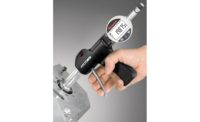My lab does a lot of fixed limit gage calibration and I sometimes wonder how the folks who deal with it on a day-to-day basis cope with it all. The situation that inspires this comment stems from the state a lot of these gages are in when we receive them. Far too often, they are dumped in a box like an assortment of nuts, bolts or used engine parts with little or no protection from damage in transit.
The purpose behind this column is prevent your gages from being rejected, not because they are worn, but because they couldn’t withstand the journey to an outside calibration facility, and thus were beyond effective calibration.
It all begins with someone who knows what they are doing—I know I’m pushing the envelope here—but this is an essential first step in the process. Someone in quality has to be actively involved in the process as opposed to a tool crib clerk or packer in a shipping department. Someone has to understand what these gages represent and what can happen if they are not treated with this in mind.
The first order of business is a visual inspection of each gage to see if it is a suitable candidate for calibration—the same sort of process that occurs when they reach the lab. What you are looking for is obvious physical damage through use or abuse that is visible to the unaided eye. If this is evident, the odds are it is significant enough to indicate the gage will not be suitable for calibration. A few dings or burrs may be removed to enable calibration to proceed if the lab you are sending them to is able to do so without making matters worse. If the gage appears beyond this level of first aid, don’t send them or you will be charged for lab people doing the same type of review. You will end up with some form of report indicating this and it will require more work on your part to sort it all out.
Your visual inspection process should include an evaluation of the surface finish of the gages. Assuming a gage has been used, it will show that but the finish will be more or less uniform in appearance. But if the precision surfaces look as though they’ve been attacked by a steel-eating disease such as rust, think twice about sending them out for calibration.
Last, but not least, was the gage originally supplied by a company that normally makes such items or is it a “one off” someone in the tool room whipped up for you? If the latter example best describes the reality involved, the chance of it passing some form of decent calibration may be slim at best. After all, gage makers would prefer to be able to make gages on a lathe rather than a grinder and while your homemade effort may meet part of the spec, the odds are it won’t pass all of it.
Proper packaging of the gages is the most critical step in sending them out for calibration. Each should be wrapped in shock-absorbing material such as foam rubber or bubble wrap. Rolling them up in several layers of newspaper won’t cut it because that’s what happens when thread plug gages are involved. They’ll cut through the paper in transit.
If you have access to the plastic-like dip the gages are coated with as new you can reduce the risk of damage in transit. Alternatively, several layers of corrugated cardboard may provide adequate protection for gages under about one inch in diameter. Once individual gages have been wrapped in this way, they should be placed in a box filled with what is known as foam peanuts: the squiggly bits of foam that stick to everything due to static electricity.
The gages should be placed in layers in the box, separated by rigid cardboard and more foam peanuts or popcorn—or even the real stuff without the butter. No movement of the gages should be detected when this box is taped closed and shaken. It should be over-boxed with similar packing all around.
In my next column on this subject I look at sending ring gages out for calibration.
Hill Cox is president of Frank Cox Metrology Ltd. (Brampton, Ontario, Canada). He may be reached at [email protected]



